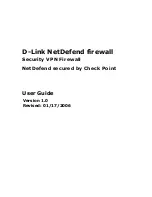
phase-1 SA every time a phase-2 negotiation has been
finished, making sure no more than one phase-2 negotiation is
encrypted using the same key.
PFS is generally not needed, since it is very unlikely that any
encryption or authentication keys will be compromised.
PFS DH Group
This specifies the Diffie-Hellman group to use with PFS. The
available DH groups are discussed below.
IPsec DH Group
This specifies the Diffie-Hellman group to use for IPsec
communication. The available DH groups are discussed
below in the section titled Diffie-Hellman Groups.
IPsec Encryption
The encryption algorithm that will be used on the protected
IPsec traffic.
This is not needed when AH is used, or when ESP is used
without encryption.
The algorithms supported by NetDefend Firewall VPNs are:
•
AES
•
Blowfish
•
Twofish
•
Cast128
•
3DES
•
DES
IPsec Authentication
This specifies the authentication algorithm used on the
protected traffic.
This is not used when ESP is used without authentication,
although it is not recommended to use ESP without
authentication.
The algorithms supported by NetDefend Firewall VPNs are:
•
SHA1
•
MD5
IPsec Lifetime
This is the lifetime of the VPN connection. It is specified in
both time (seconds) and data amount (kilobytes). Whenever
either of these values is exceeded, a re-key will be initiated,
providing new IPsec encryption and authentication session
keys. If the VPN connection has not been used during the last
re-key period, the connection will be terminated, and
re-opened from scratch when the connection is needed again.
This value must be set lower than the IKE lifetime.
Diffie-Hellman Groups
Diffie-Hellman (DH) is a cryptographic protocol that allows two parties that have no prior
knowledge of each other to establish a shared secret key over an insecure communications channel
9.3.2. Internet Key Exchange (IKE)
Chapter 9. VPN
402
Summary of Contents for NetDefend DFL-260E
Page 27: ...1 3 NetDefendOS State Engine Packet Flow Chapter 1 NetDefendOS Overview 27...
Page 79: ...2 7 3 Restore to Factory Defaults Chapter 2 Management and Maintenance 79...
Page 146: ...3 9 DNS Chapter 3 Fundamentals 146...
Page 227: ...4 7 5 Advanced Settings for Transparent Mode Chapter 4 Routing 227...
Page 241: ...5 4 IP Pools Chapter 5 DHCP Services 241...
Page 339: ...6 7 Blacklisting Hosts and Networks Chapter 6 Security Mechanisms 339...
Page 360: ...7 4 7 SAT and FwdFast Rules Chapter 7 Address Translation 360...
Page 382: ...8 3 Customizing HTML Pages Chapter 8 User Authentication 382...
Page 386: ...The TLS ALG 9 1 5 The TLS Alternative for VPN Chapter 9 VPN 386...
Page 439: ...Figure 9 3 PPTP Client Usage 9 5 4 PPTP L2TP Clients Chapter 9 VPN 439...
Page 450: ...9 7 6 Specific Symptoms Chapter 9 VPN 450...
Page 488: ...10 4 6 Setting Up SLB_SAT Rules Chapter 10 Traffic Management 488...
Page 503: ...11 6 HA Advanced Settings Chapter 11 High Availability 503...
Page 510: ...12 3 5 Limitations Chapter 12 ZoneDefense 510...
Page 533: ...13 9 Miscellaneous Settings Chapter 13 Advanced Settings 533...
















































